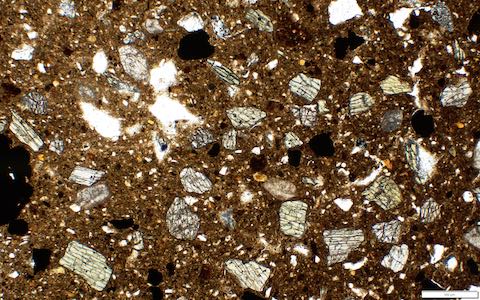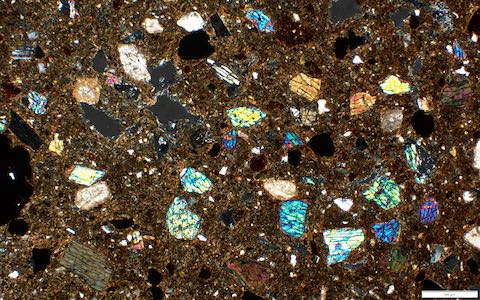

| None (0) | Minor (1) | Few (2) | Common (3) | Frequent (4) | Major (5) | Very Dominant (6) |
| 0% | 0-5% | 5-15% | 15-30 % | 30-50% | 50-70% | 70-100% |
| Name | Cal. | Quartz | Feldspar | Pyroxene | Amphibole | Opaques | Olivine | Biotite | Muscovite | Epidote | Garnet/ Spinel | Ig./Met. Rocks | Sed. Rocks | Grog | Lithics/ Region |
|---|---|---|---|---|---|---|---|---|---|---|---|---|---|---|---|
| tpr274 | 1 | 1 | 3 | 6 | 1 | 2 | 0 | 0 | 0 | 0 | 0 | 3 | 0 | 0 | vitric, microlitic, lathwork |
| Huon pyroxenic | 0 | 0 | 1 | 5 | 0 | 0 | 0 | 0 | 0 | 0 | 0 | 1 | 0 | 0 | PNG |
| Slide | Fabric | Possible Origin | Cal. | Quartz | Feldspar | Pyroxene | Amphibole | Opaques | Olivine | Biotite | Muscovite | Epidote | Garnet/ Spinel | Ig./Met. Rocks | Sed. Rocks | Grog | Lithics |
|---|---|---|---|---|---|---|---|---|---|---|---|---|---|---|---|---|---|
| IL_1_92 | tpr274 (Huon pyroxenic) | Mindiri | 1 | 0 | 2 | 5 | 0 | 2 | 0 | 0 | 0 | 0 | 0 | 2 | 0 | 0 | microlitic |


Pyroxene grains are colourless to pale green, angular to subrounded, about 0.3 mm across. There are minor of small angular quartz or feldspar, minor magnetite and minor shelly fragments. Minor volcanic rock fragments are set in the brown clay.